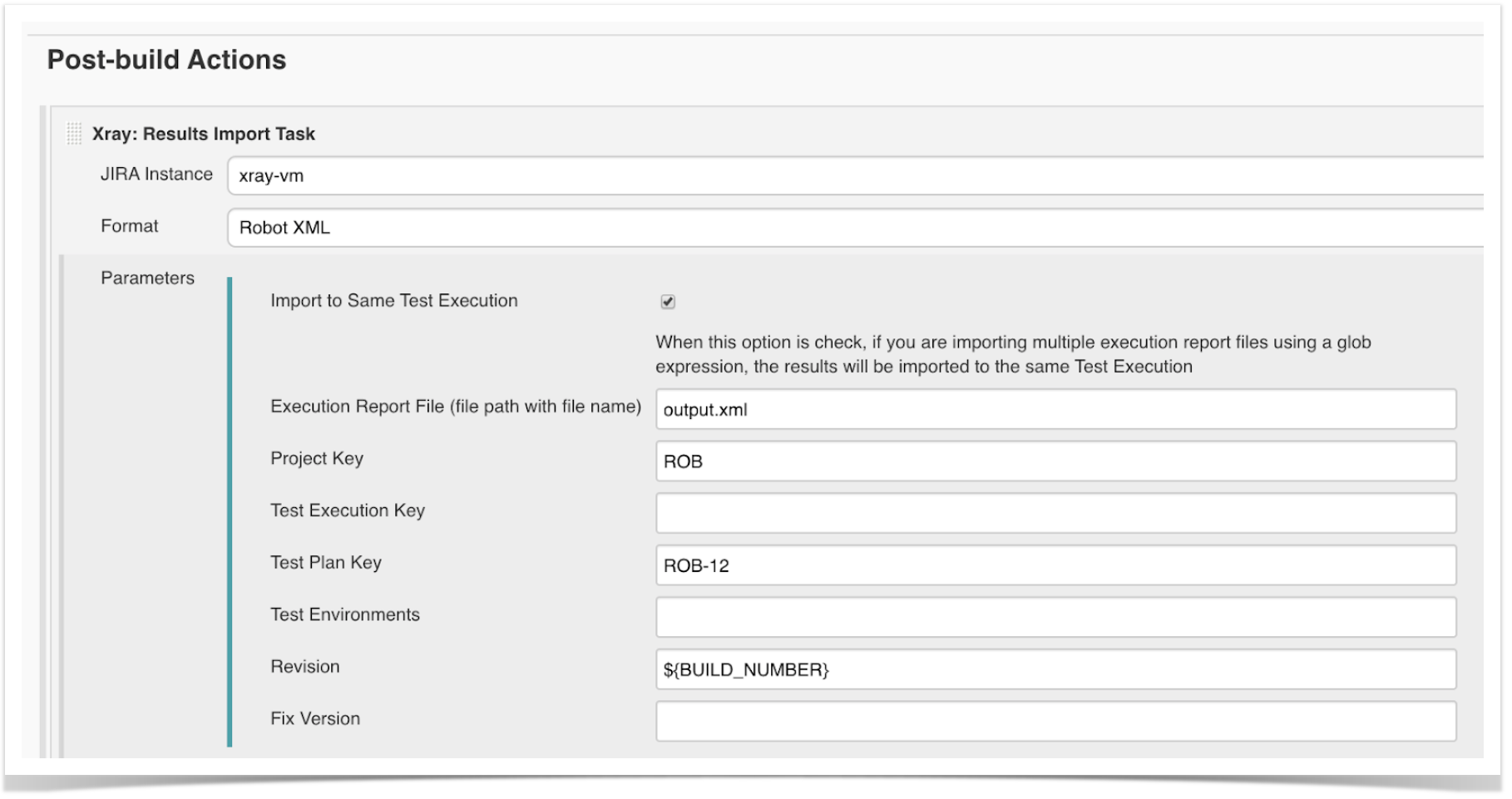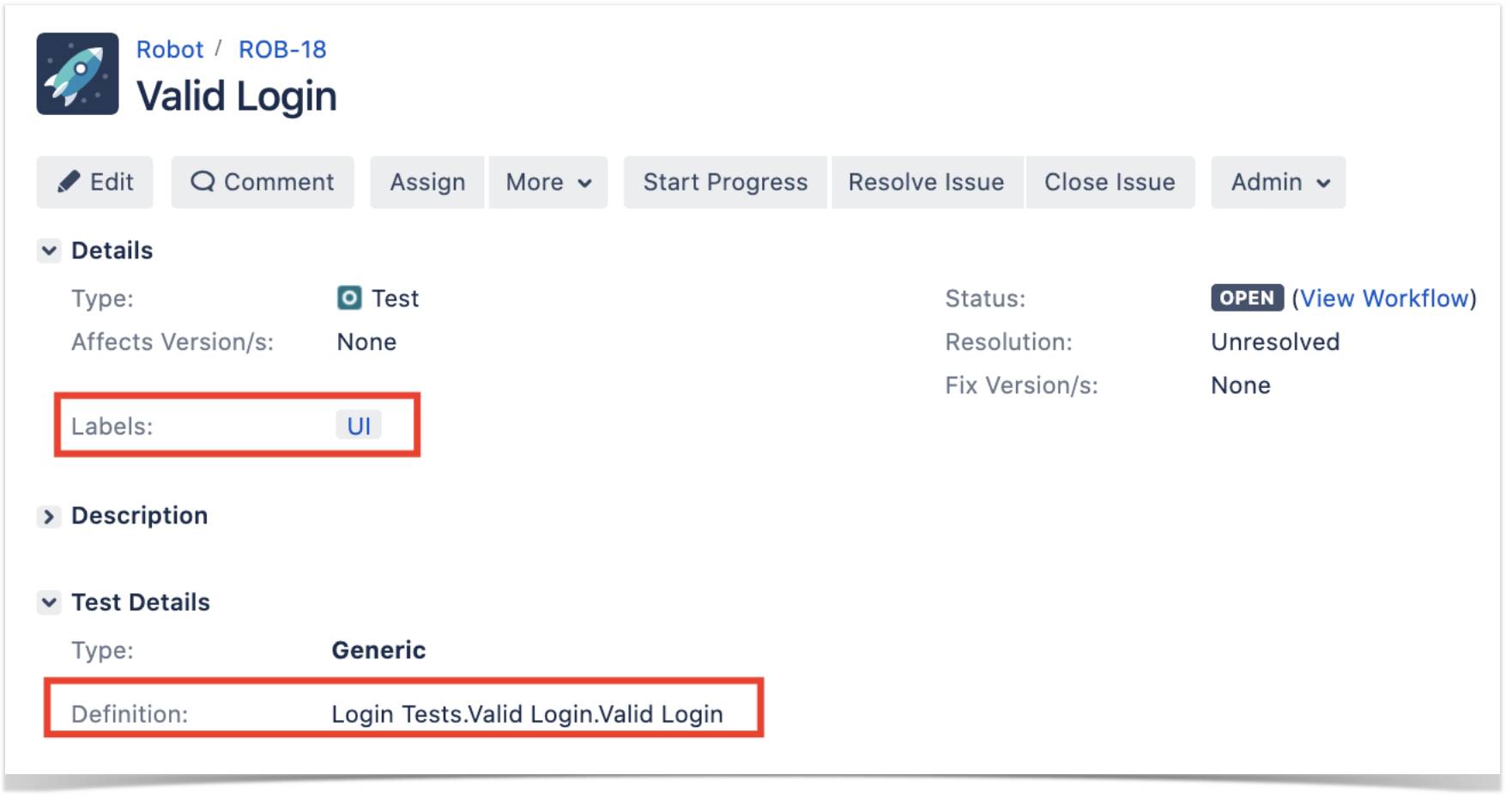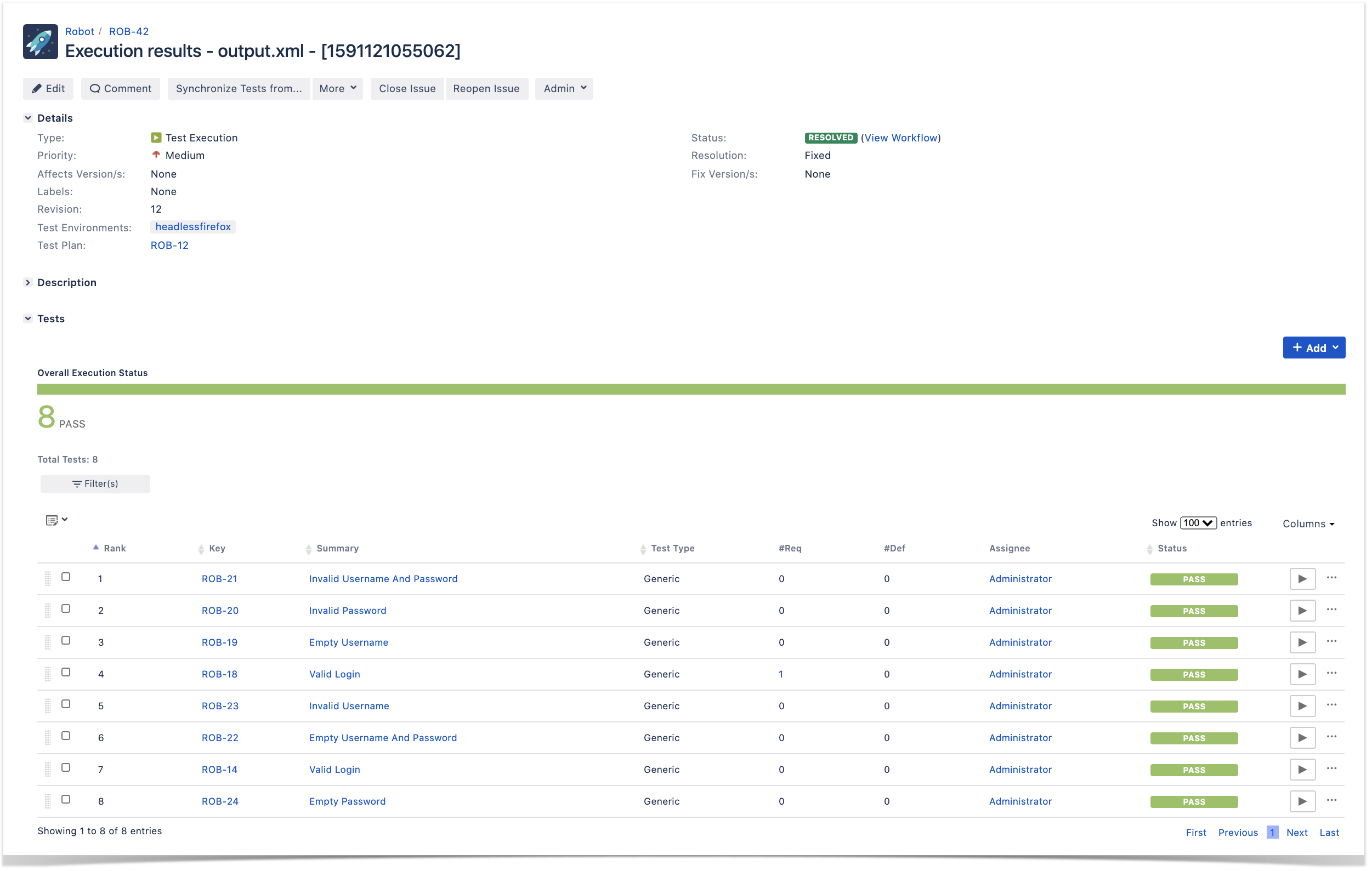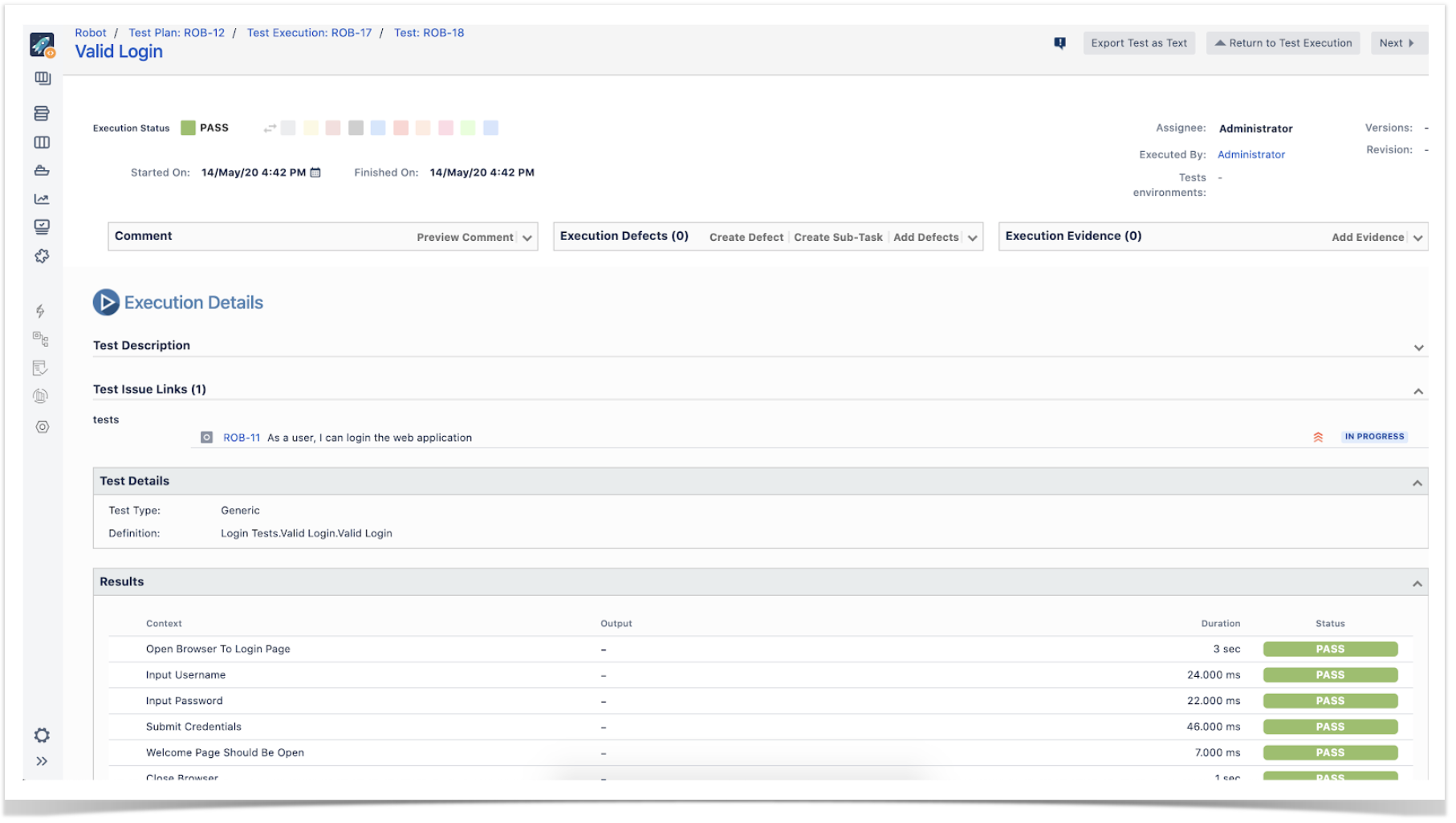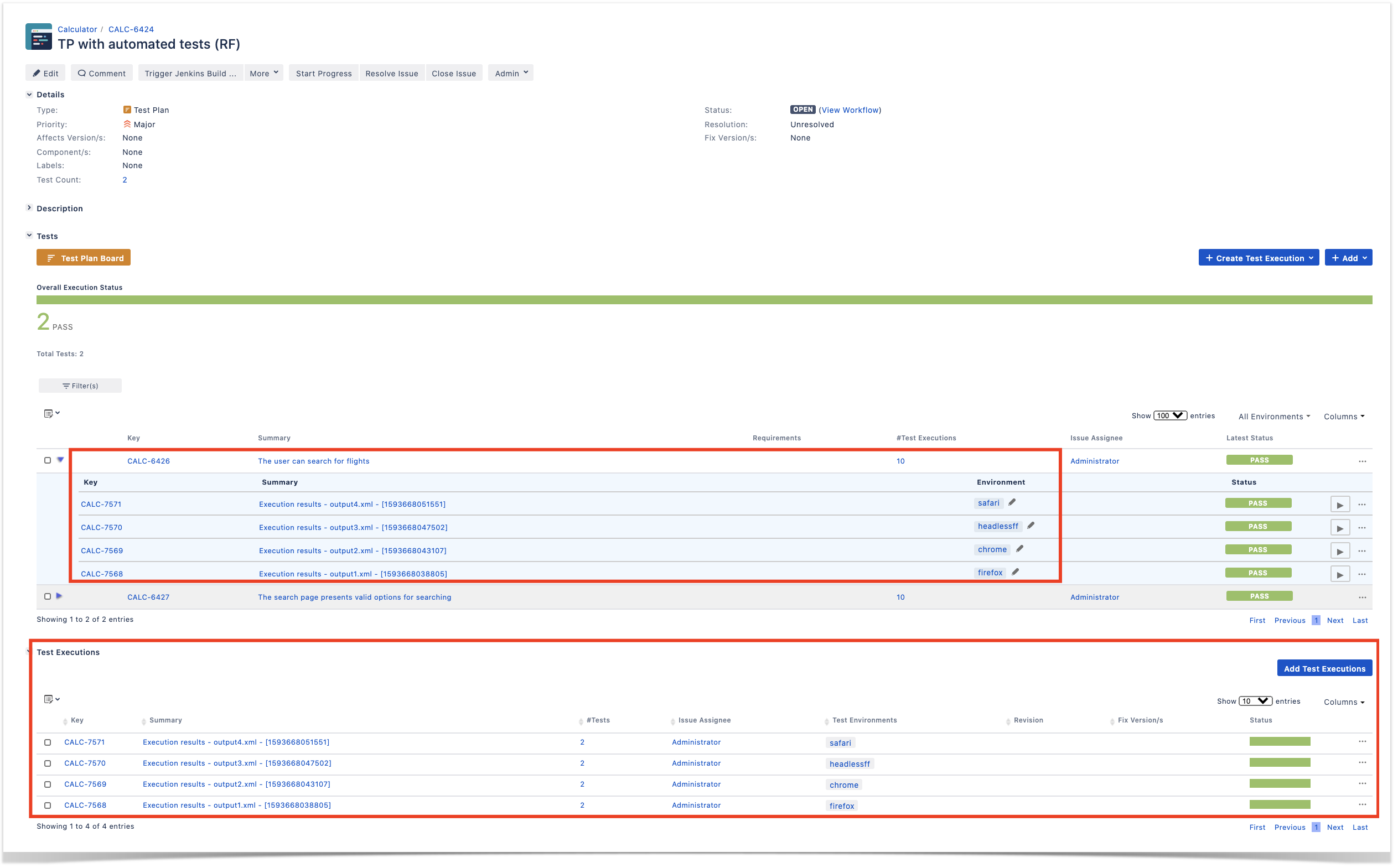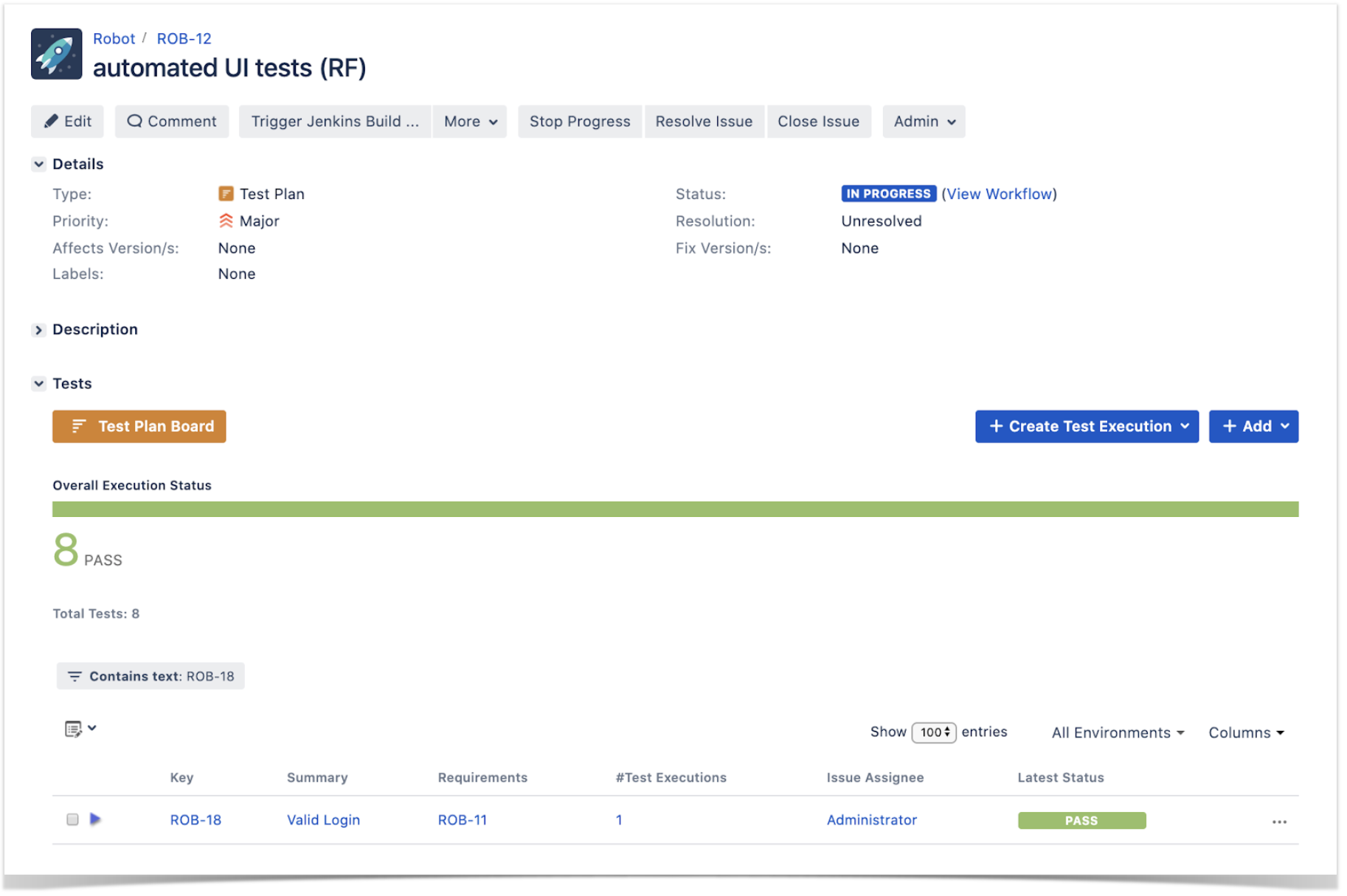Page History
| Table of Contents |
|---|
Overview
...
Broadly speaking, it can be used to automate acceptance “test cases” (i.e. scripts) no matter the moment you decide to do so or the practices your team follows even though it's preferable to do it at start, involving the whole team in order to pursue shared understanding.
In in this tutorialarticle, we will specify some tests using Robot Framework assuming that your team is adopting ATDD and see how we can have visibility of the corresponding results in Jira, using Xray.
This tutorial explores the specific integration Xray provides for Robot Framework XML reports.
| Info |
|---|
You may find the full source for this example in this GitHub repository. |
Requirements
Common requirements
- Robot Framework
- SeleniumLibrary
- Java (if using the Java variant of the "Robot Framework")
...
Examples
The full ATDD workflow
In this example we're going to validate a dummy website (provided in the GitHub repository), checking for valid and invalid logins.
| Info |
|---|
You may find the full source for this example in this GitHub repository, which corresponds in essence to previous work by Pekka Klärck from the Robot Framework Foundation. |
If the team is adopting ATDD and working collaboratively in order to have a shared understanding of what is going to be developed, why and some concrete examples of usage, then the flow would be something similar to the following diagram.
...
| Code Block | ||||
|---|---|---|---|---|
| ||||
*** Settings ***
Documentation A test suite with a single test for valid login.
...
... This test has a workflow that is created using keywords in
... the imported resource file.
Resource resource.robot
*** Test Cases ***
Valid Login
[Tags] ROB-11 UI
Open Browser To Login Page
Input Username demo
Input Password mode
Submit Credentials
Welcome Page Should Be Open
[Teardown] Close Browser |
The previous Robot file use uses a common resource that contains some generic variables and some reusable "keywords" (i.e., steps).
| Code Block | ||||
|---|---|---|---|---|
| ||||
*** Settings ***
Documentation A resource file with reusable keywords and variables.
...
... The system specific keywords created here form our own
... domain specific language. They utilize keywords provided
... by the imported SeleniumLibrary.
Library SeleniumLibrary
*** Variables ***
${SERVER} 192.168.56.1:7272
${BROWSER} Firefox
${DELAY} 0
${VALID USER} demo
${VALID PASSWORD} mode
${LOGIN URL} http://${SERVER}/
${WELCOME URL} http://${SERVER}/welcome.html
${ERROR URL} http://${SERVER}/error.html
*** Keywords ***
Open Browser To Login Page
Open Browser ${LOGIN URL} ${BROWSER}
Maximize Browser Window
Set Selenium Speed ${DELAY}
Login Page Should Be Open
Login Page Should Be Open
Title Should Be Login Page
Go To Login Page
Go To ${LOGIN URL}
Login Page Should Be Open
Input Username
[Arguments] ${username}
Input Text username_field ${username}
Input Password
[Arguments] ${password}
Input Text password_field ${password}
Submit Credentials
Click Button login_button
Welcome Page Should Be Open
Location Should Be ${WELCOME URL}
Title Should Be Welcome Page |
Running the tests can be done from the command line or from within Jenkins (or any other CI tool); this will produce a XML based report (e.g. output.xml).
Importing results is as easy as submitting them to the REST API with a POST request (e.g. curl), or by using one of the CI plugins available for free (e.g. Xray Jenkins plugin).
| Info | ||||
|---|---|---|---|---|
| ||||
Running tests is primarily done using the "robot" utility which provides many options that allow you to define which tests to run, the output directory and more. You may also specify some variables and their values. Next follows some different usage examples. If you're using Python:
If you're using Java:
|
An unstructured (i.e. "Generic") A Test issue will be auto-provisioned the first time you import the results, based on the name of the test case and of the corresponding test suites.
...
Otherwise, tags are mapped as labels on the corresponding Test issue.
Importing results is as easy as submitting them to the REST API with a POST request (e.g. curl), or by using one of the CI plugins available for free (e.g. Xray Jenkins plugin).
| Info | ||
|---|---|---|
| ||
Note that Robot Framework considers the base folder of the project as the first test suite. The way you run your tests also affects Robot's XML; so, if you execute the file from somewhere else or you execute the file directly by passing it as an argument, the test suite's information will potentially be different. |
A Test Execution will be created containing results for all test cases executed. In this case, you can see that it is also linked back to an existing Test Plan where you can track the consolidated results from multiple "iterations" (i.e. Test Executions).
Within the execution screen details, accessible from each row, you In Jira, using Xray, the team can look at the Test Run details which include the overall result and also specifics about each keyword, including duration and status.
We can all see that a Test case/issue was auto-provisioned based on the name of the test case and of the corresponding test suites.
After running the tests and generating the Robot XML report (e.g., output.xml), it can be imported to Xray via the REST API.
If you're using Python:
| No Format |
|---|
robot -d output . |
If you're using Java:
| No Format |
|---|
java -jar robotframework-3.0.jar -d output . |
Each Robot's test case is mapped to a Generic Test in Jira, having the summary with the name of the test case, and the Generic Test Definition field contains the concatenated names of the test suites along with the name of the test case. Note that Robot Framework considers the base folder of the project as the first test suite. The way you run your tests also affects Robot's XML; so, if you execute the file from somewhere else or you execute the file directly by passing it as an argument, the test suite's information will potentially be different.
You will see information about each Robot keyword (i.e., step) and its corresponding status in the Context section of the Execution Details of the Generic Test.
Running tests in parallel, against different environments
In this distinct and more evolved example we're going to run tests in parallel using "pabot"; we'll also take advantage of the Test Environments concept provided by Xray.
This example uses a fake travel agency site (kindly provided by BlazeMeter) as the testing target.
We have two tests that use low-level keywords (note: this is not a good practice; it's just for simplicity) and one of those keywords is defined within a SeleniumLibrary plugin (i.e. it extends the keywords provided by SeleniumLibrary).
| Code Block | ||||
|---|---|---|---|---|
| ||||
*** Settings ***
Library SeleniumLibrary plugins=${CURDIR}/MyPlugin.py
Library Collections
Suite Setup Open browser ${URL} ${BROWSER}
Suite Teardown Close All Browsers
*** Variables ***
${URL} http://blazedemo.com/
${BROWSER} Chrome
@{allowed_destinations} Buenos Aires Rome London Berlin New York Dublin Cairo
*** Test Cases ***
The search page presents valid options for searching
[Tags] 1
Go To ${URL}
Title Should Be BlazeDemo
Element Should Be Visible css:input[type='submit']
Wait Until Element Is Enabled css:input[type='submit']
Wait Until Element Is Clickable input[type='submit']
${values}= Get List Items xpath://select[@name='fromPort'] values=True
Log ${values}
${allowed_departures}= Create List Paris Philadelphia Boston Portland San Diego Mexico City São Paolo
Lists Should Be Equal ${allowed_departures} ${values}
${values}= Get List Items xpath://select[@name='toPort'] values=True
Log ${values}
Should Be Equal ${allowed_destinations} ${values}
The user can search for flights
[Tags] search_flights
Go to ${URL}
Select From List By Value xpath://select[@name='fromPort'] Paris
Select From List by Value xpath://select[@name='toPort'] London
Click Button css:input[type='submit']
@{flights}= Get WebElements css:table[class='table']>tbody tr
Should Not Be Empty ${flights} |
| Code Block | ||||||
|---|---|---|---|---|---|---|
| ||||||
from robot.api import logger
from SeleniumLibrary.base import LibraryComponent, keyword
from SeleniumLibrary.locators import ElementFinder
from selenium.webdriver.support.ui import WebDriverWait
from selenium.webdriver.support.expected_conditions import presence_of_element_located
from selenium.webdriver.support.expected_conditions import element_to_be_clickable
from selenium.webdriver.common.keys import Keys
from selenium.webdriver.common.by import By
class MyPlugin(LibraryComponent):
def __init__(self, ctx):
LibraryComponent.__init__(self, ctx)
@keyword
def wait_until_element_is_clickable(self, selector):
"""Adding new keyword: Wait Until Element Is Clickable."""
self.info('Wait Until Element Is Clickable')
wait = WebDriverWait(self.driver, 10)
my_elem = self.element_finder.find("css:"+selector)
print(my_elem)
first_result = wait.until(element_to_be_clickable((By.CSS_SELECTOR, selector)))
return first_result
|
Running the tests in parallel is possible using pabot.
Tests can be parallelized in different ways; we'll split them for running on a test basis.
We can also specify some variables; in this case, we'll use it to specify the "BROWSER" variable which is passed to the SeleniumLibrary.
| Code Block | ||||
|---|---|---|---|---|
| ||||
--variable BROWSER:Chrome |
| No Format |
|---|
pabot --argumentfile1 ffbrowser.txt --argumentfile2 chromebrowser.txt --argumentfile3 headlessffbrowser.txt --argumentfile4 safaribrowser.txt --testlevelsplit 0_basic/search_flights.robot |
Running these tests will produce a report per each "argumentfileX" parameter (i.e. per each browser). We can then submit those to Xray (e.g. using "curl" and the REST API), and assign it to distinct Test Executions where each one is in turn assigned to a specific Test Environment identifying the browser.
| Code Block | ||||||
|---|---|---|---|---|---|---|
| ||||||
#!/bin/bash
BROWSERS=(firefox chrome headlessff safari)
PROJECT=CALC
TESTPLAN=CALC-6424
i=1
for browser in ${BROWSERS[@]}; do
curl -H "Content-Type: multipart/form-data" -u admin:admin -F "file=@pabot_results/output$i.xml" "http://jiraserver.example.com/rest/raven/1.0/import/execution/robot?projectKey=$PROJECT&testPlanKey=$TESTPLAN&testEnvironments=$browser"
i=$((i+1))
done |
In Xray, at the Test Plan-level we can see the consolidated results and for each test case we may drill-down and see all the runs performed and in which environment/browser.
In this case, we have the total of 4 Test Executions (i.e. for safari, headlessff, chrome, firefox).
Tracking automation results
Besides tracking automation results on the Test Execution issues themselves, it's also possible to track in different places so the team gets fully aware of them.
...
On the user story issue screen
...
At the Test Plan-level, the entity that defines the scope of testing and tracks its progress, we can quickly assess the latest consolidated test results (i.e. the latest result obtained for each Test being tracked).
References
Code used in this demo
Automation topic in Xray’s documentation
Xray and Robot Framework integration (includes tutorials)
REST API, Jenkins, Bamboo, Team City and integration with other CI tools
https://confluence.xpand-it.com/pages/viewpage.action?pageId=21761014- Integration capabilities that Xray provides for Robot Framework XML reports
- pabot

